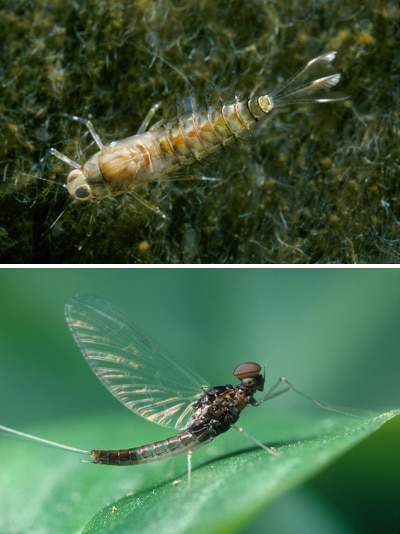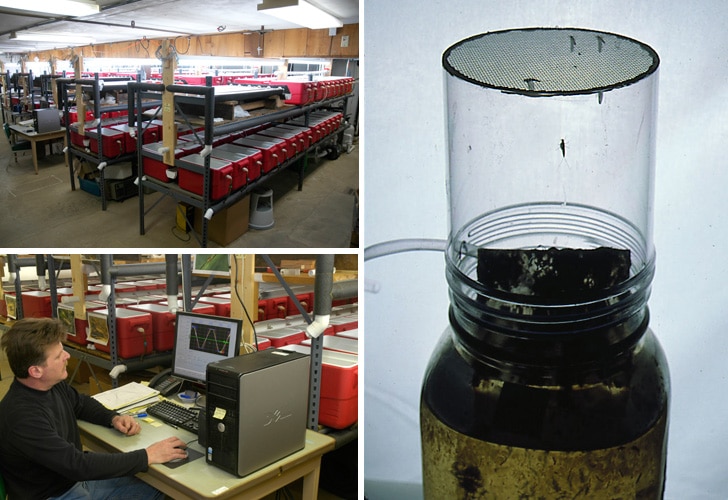
The larval (top) and adult forms of Procloeon rivulare, one of the mayfly species used in the Stroud Center’s temperature studies. Photos: David Funk
If you’ve ever been fly fishing, you probably know what a mayfly looks like. These delicate insects are a tasty treat for freshwater trout and other aquatic species. They are also a hallmark of healthy streams and rivers. When mayfly populations decline, it’s a warning that something has gone wrong. But what?
John Jackson, Ph.D., who leads the Entomology Group at Stroud Water Research Center, says it could be a variety of things, including nutrient and sediment pollution from nearby farms, or temperature changes from industrial discharge, global warming, or deforestation along streambanks — trees provide shade and help keep temperatures cool.
“Until we know why mayflies are dying, we can’t determine what the remedy might be,” Jackson says.
To better understand the role temperature plays in the growth, endurance, or loss of mayfly populations, Stroud Water Research Center in collaboration with North Carolina State University, the University of Arizona, and Utah State University received a grant from the National Science Foundation to determine the effects of temperature on six different species of mayflies throughout their life cycles. The Stroud Center will receive $501,157 over the 3-year project (NSF award number 1456278).
Low Dissolved Oxygen the Culprit?
Director and Senior Research Scientist Bern Sweeney, Ph.D., says, “The warmer the water, the lower the amount of dissolved oxygen in the water but the higher the oxygen need of mayflies due to increased metabolism. A prevailing hypothesis is that this mismatch causes the mayflies to die, in other words, higher temperatures indirectly kill mayflies because there is less oxygen available. But we’re finding that specific genes that should be activated in response to temperature-induced oxygen deprivation are not being activated at temperatures at or near mayfly death, so death may be related to other factors associated with stress at high temperatures.”
“It’s important to know not only the temperatures at which mayflies die but also the temperatures that affect the health of mayflies and their ability to reproduce and sustain a population. One degree can make a difference when you are on the edge,” says entomologist David Funk.
Rearing Mayflies in Picnic Coolers and Mason Jars
The Stroud Center has spent years perfecting a process for rearing mayflies in the lab that allows scientists to start experiments with thousands of mayfly larvae hatched from eggs all on the same day, a huge benefit that ensures greater accuracy when comparing how mayflies respond to different temperatures and eliminates the need to collect enough mayflies of approximately the same age in the field.
Using red picnic coolers, Funk created seven water baths, each a different temperature, in which he reared mayflies inside Mason jars. Stroud Center scientists then measured how many survived, how well they developed, and how many offspring they could produce under a variety of temperature conditions. “We started with a broad range of temperatures and narrowed down to a smaller range of those temperatures that seemed critical,” says Funk.
Larger size correlates with more offspring. However, growth takes time, and larger mayflies have fewer offspring cycles, so the scientists applied a metric to determine the sweet spot between size and development time that leads to the greatest gains in population growth, what Funk calls their “reproductive potential.”
Specimens involved in the experiments will be forwarded to North Carolina State University researchers, who will investigate the role that genes play in how mayflies respond to temperature, and to researchers at the University of Arizona to investigate how temperature affects energy expenditure at the expense of reproductive output, and results will be forwarded to Utah State University researchers, who will compare lab results to what they observe in the field.
“This study is unique in that it connects physiology and gene expression to life-history characteristics, giving us a more detailed understanding of how temperature affects mayflies either positively or negatively,” says Jackson.

The Stroud Center has spent years perfecting a process for rearing mayflies in the lab. Clockwise from top left: racks of repurposed picnic coolers provide space for rearing mayflies in water baths of different temperatures; emerging mayflies will be weighed and measured and their reproductive output recorded; the temperature conditions in the rearing lab are carefully controlled in order to ensure treatments are consistent for the duration of the experiments. Photos: David Funk



